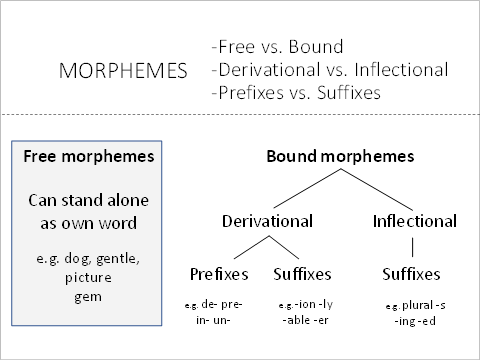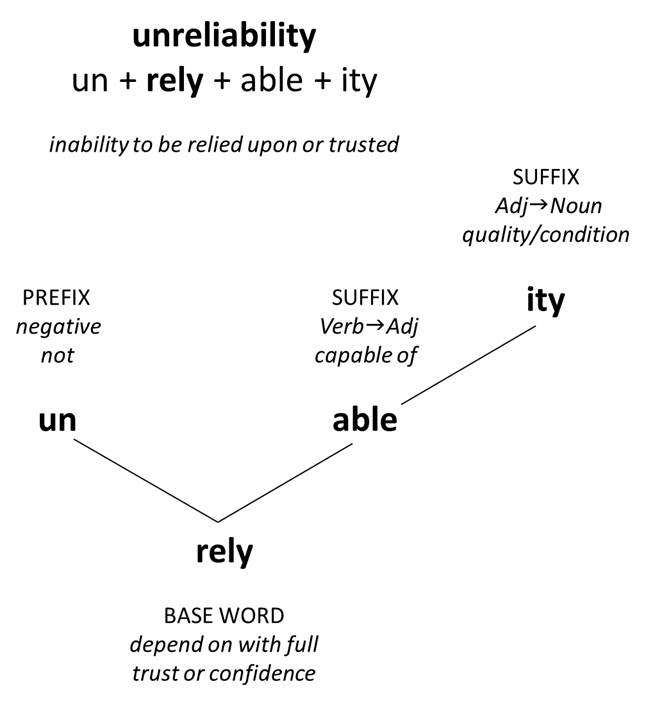Word is the principal and
basic unit of the language system, the largest on the morphologic and
the smallest on the syntactic plane of linguistic analysis.
According
to the number of morphemes words can be classified into monomorphic
and polymorphic. Monomorphic or root-words consist of only one
root-morpheme, e.g. small, dog, make, give, etc. All polymorphic word
fall into two subgroups: derived words and compound words –
according to the number of root-morphemes they have. Derived words
are composed of one root-morpheme and one or more derivational
morphemes, e.g. acceptable, outdo, disagreeable, etc. Compound words
are those which contain at least two root-morphemes, the number of
derivational morphemes being insignificant.
There can be both root- and
derivational morphemes in compounds as in pen-holder,
light-mindedness, or only root-morphemes as in lamp-shade, eye-ball,
etc.
The
term morpheme
is derived from Greek
morphe
“form ”+ -eme.
The Greek suffix –eme
has been adopted by linguistic to denote the smallest unit or the
minimum distinctive
feature.
The morpheme is the smallest
meaningful unit of form. A form in these cases a recurring discrete
unit of speech. Morphemes occur in speech only as constituent parts
of words, not independently, although a word may consist of single
morpheme.
The
root-morpheme
is the lexical nucleus of the word; it has a very general and
abstract lexical meaning common to a set of semantically related
words constituting one word-cluster, e.g. (to) teach,
teacher, teaching.
Besides the lexical meaning root-morphemes possess all other types of
meaning proper to morphemes except the part-of-speech meaning which
is not found in roots.
Affixational
morphemes
include inflectional affixes or inflections and derivational affixes.
Inflections
carry only grammatical meaning and are thus relevant only for the
formation of word-forms. Derivational
affixes
are relevant for building various types of words. They are lexically
always dependent on the root which they modify. They possess the same
types of meaning as found in roots, most of them have the
part-of-speech meaning which makes them structurally the important
part of the word as they condition the lexico-grammatical class the
word belongs to. Due to this component of their meaning the
derivational affixes are classified into affixes building different
parts of speech: nouns, verbs, adjectives or adverbs.
Roots
and derivational affixes are generally easily distinguished and the
difference between them is clearly felt as, e.g., in the words
helpless,
handy, blackness, Londoner, refill,
etc.: the root-morphemes help-,
hand-, black-, London-, fill-,
are understood as the lexical centers of the words, and –less,
-y, -ness, -er, re-
are
felt as morphemes dependent on these roots.
Distinction is also made of
free and bound morphemes.
Free
morphemes
coincide with word-forms of independently functioning words. It is
obvious that free morphemes can be found only among roots, so the
morpheme boy-
in the word boy
is a free morpheme; in the word undesirable
there is only one free morpheme desire-;
the word pen-holder
has two free morphemes pen-
and
hold-.
It follows that bound
morphemes
are those that do not coincide with separate word- forms,
consequently all derivational morphemes, such as –ness,
-able, -er
are bound. Root-morphemes may be both free and bound. The morphemes
theor-
in the words theory,
theoretical, or
horr-
in the words horror,
horrible, horrify; Angl- in
Anglo-Saxon; Afr-
in Afro-Asian
are all bound roots as there are no identical word-forms.
The
stem
is defined as that part of the word which remains unchanged
throughout its paradigm, thus the stem which appears in the paradigm
(to) ask
( ), asks,
asked, asking is
ask-;
the
stem of the word singer
(
), singer’s,
singers, singers’ is
singer-.
It is the stem of the word that takes the inflections which shape the
word grammatically as one or another part of speech.
Simple
stems are
semantically non-motivated and do not constitute a pattern on analogy
with which new stems may be modeled.
Simple
stems are generally monomorphic and phonetically identical with the
root morpheme.
Retain, receive, horrible, pocket, motion, etc.
should be regarded as simple, non- motivated stems.
Derived
stems – root
and derivational affix.
Compound
stems are
made up of two IC’s, both of which are themselves stems, for
example match-box,
driving-suit, pen-holder,
etc. It is built by joining of two stems, one of which is simple, the
other derived.
Bound
stem – is
not harmonious to a separate word.
To
study the motivation of the word the method of immediate ultimate
consistent is used. It is based on bannery opposition – each state
of segmentation involves 2 components words brake into.
Соседние файлы в предмете [НЕСОРТИРОВАННОЕ]
- #
- #
- #
- #
- #
- #
- #
- #
- #
- #
- #
WORD STRUCTURE IN MODERN ENGLISH
I. The morphological structure of a word. Morphemes. Types of morphemes. Allomorphs.
II. Structural types of words.
III. Principles of morphemic analysis.
IV. Derivational level of analysis. Stems. Types of stems. Derivational types of words.
I. The morphological structure of a word. Morphemes. Types of Morphemes. Allomorphs.
There are two levels of approach to the study of word- structure: the level of morphemic analysis and the level of derivational or word-formation analysis.
Word is the principal and basic unit of the language system, the largest on the morphologic and the smallest on the syntactic plane of linguistic analysis.
It has been universally acknowledged that a great many words have a composite nature and are made up of morphemes, the basic units on the morphemic level, which are defined as the smallest indivisible two-facet language units.
The term morpheme is derived from Greek morphe “form ”+ -eme. The Greek suffix –eme has been adopted by linguistic to denote the smallest unit or the minimum distinctive feature.
The morpheme is the smallest meaningful unit of form. A form in these cases a recurring discrete unit of speech. Morphemes occur in speech only as constituent parts of words, not independently, although a word may consist of single morpheme. Even a cursory examination of the morphemic structure of English words reveals that they are composed of morphemes of different types: root-morphemes and affixational morphemes. Words that consist of a root and an affix are called derived words or derivatives and are produced by the process of word building known as affixation (or derivation).
The root-morpheme is the lexical nucleus of the word; it has a very general and abstract lexical meaning common to a set of semantically related words constituting one word-cluster, e.g. (to) teach, teacher, teaching. Besides the lexical meaning root-morphemes possess all other types of meaning proper to morphemes except the part-of-speech meaning which is not found in roots.
Affixational morphemes include inflectional affixes or inflections and derivational affixes. Inflections carry only grammatical meaning and are thus relevant only for the formation of word-forms. Derivational affixes are relevant for building various types of words. They are lexically always dependent on the root which they modify. They possess the same types of meaning as found in roots, but unlike root-morphemes most of them have the part-of-speech meaning which makes them structurally the important part of the word as they condition the lexico-grammatical class the word belongs to. Due to this component of their meaning the derivational affixes are classified into affixes building different parts of speech: nouns, verbs, adjectives or adverbs.
Roots and derivational affixes are generally easily distinguished and the difference between them is clearly felt as, e.g., in the words helpless, handy, blackness, Londoner, refill, etc.: the root-morphemes help-, hand-, black-, London-, fill-, are understood as the lexical centers of the words, and –less, -y, -ness, -er, re- are felt as morphemes dependent on these roots.
Distinction is also made of free and bound morphemes.
Free morphemes coincide with word-forms of independently functioning words. It is obvious that free morphemes can be found only among roots, so the morpheme boy- in the word boy is a free morpheme; in the word undesirable there is only one free morpheme desire-; the word pen-holder has two free morphemes pen- and hold-. It follows that bound morphemes are those that do not coincide with separate word- forms, consequently all derivational morphemes, such as –ness, -able, -er are bound. Root-morphemes may be both free and bound. The morphemes theor- in the words theory, theoretical, or horr- in the words horror, horrible, horrify; Angl- in Anglo-Saxon; Afr- in Afro-Asian are all bound roots as there are no identical word-forms.
It should also be noted that morphemes may have different phonemic shapes. In the word-cluster please , pleasing , pleasure , pleasant the phonemic shapes of the word stand in complementary distribution or in alternation with each other. All the representations of the given morpheme, that manifest alternation are called allomorphs/or morphemic variants/ of that morpheme.
The combining form allo- from Greek allos “other” is used in linguistic terminology to denote elements of a group whose members together consistute a structural unit of the language (allophones, allomorphs). Thus, for example, -ion/ -tion/ -sion/ -ation are the positional variants of the same suffix, they do not differ in meaning or function but show a slight difference in sound form depending on the final phoneme of the preceding stem. They are considered as variants of one and the same morpheme and called its allomorphs.
Allomorph is defined as a positional variant of a morpheme occurring in a specific environment and so characterized by complementary description.
Complementary distribution is said to take place, when two linguistic variants cannot appear in the same environment.
Different morphemes are characterized by contrastive distribution, i.e. if they occur in the same environment they signal different meanings. The suffixes –able and –ed, for instance, are different morphemes, not allomorphs, because adjectives in –able mean “ capable of beings”.
Allomorphs will also occur among prefixes. Their form then depends on the initials of the stem with which they will assimilate.
Two or more sound forms of a stem existing under conditions of complementary distribution may also be regarded as allomorphs, as, for instance, in long a: length n.
II. Structural types of words.
The morphological analysis of word- structure on the morphemic level aims at splitting the word into its constituent morphemes – the basic units at this level of analysis – and at determining their number and types. The four types (root words, derived words, compound, shortenings) represent the main structural types of Modern English words, and conversion, derivation and composition the most productive ways of word building.
According to the number of morphemes words can be classified into monomorphic and polymorphic. Monomorphic or root-words consist of only one root-morpheme, e.g. small, dog, make, give, etc. All polymorphic word fall into two subgroups: derived words and compound words – according to the number of root-morphemes they have. Derived words are composed of one root-morpheme and one or more derivational morphemes, e.g. acceptable, outdo, disagreeable, etc. Compound words are those which contain at least two root-morphemes, the number of derivational morphemes being insignificant. There can be both root- and derivational morphemes in compounds as in pen-holder, light-mindedness, or only root-morphemes as in lamp-shade, eye-ball, etc.
These structural types are not of equal importance. The clue to the correct understanding of their comparative value lies in a careful consideration of: 1)the importance of each type in the existing wordstock, and 2) their frequency value in actual speech. Frequency is by far the most important factor. According to the available word counts made in different parts of speech, we find that derived words numerically constitute the largest class of words in the existing wordstock; derived nouns comprise approximately 67% of the total number, adjectives about 86%, whereas compound nouns make about 15% and adjectives about 4%. Root words come to 18% in nouns, i.e. a trifle more than the number of compound words; adjectives root words come to approximately 12%.
But we cannot fail to perceive that root-words occupy a predominant place. In English, according to the recent frequency counts, about 60% of the total number of nouns and 62% of the total number of adjectives in current use are root-words. Of the total number of adjectives and nouns, derived words comprise about 38% and 37% respectively while compound words comprise an insignificant 2% in nouns and 0.2% in adjectives. Thus it is the root-words that constitute the foundation and the backbone of the vocabulary and that are of paramount importance in speech. It should also be mentioned that root words are characterized by a high degree of collocability and a complex variety of meanings in contrast with words of other structural types whose semantic structures are much poorer. Root- words also serve as parent forms for all types of derived and compound words.
III. Principles of morphemic analysis.
In most cases the morphemic structure of words is transparent enough and individual morphemes clearly stand out within the word. The segmentation of words is generally carried out according to the method of Immediate and Ultimate Constituents. This method is based on the binary principle, i.e. each stage of the procedure involves two components the word immediately breaks into. At each stage these two components are referred to as the Immediate Constituents. Each Immediate Constituent at the next stage of analysis is in turn broken into smaller meaningful elements. The analysis is completed when we arrive at constituents incapable of further division, i.e. morphemes. These are referred to Ultimate Constituents.
A synchronic morphological analysis is most effectively accomplished by the procedure known as the analysis into Immediate Constituents. ICs are the two meaningful parts forming a large linguistic unity.
The method is based on the fact that a word characterized by morphological divisibility is involved in certain structural correlations. To sum up: as we break the word we obtain at any level only ICs one of which is the stem of the given word. All the time the analysis is based on the patterns characteristic of the English vocabulary. As a pattern showing the interdependence of all the constituents segregated at various stages, we obtain the following formula:
un+ { [ ( gent- + -le ) + -man ] + -ly}
Breaking a word into its Immediate Constituents we observe in each cut the structural order of the constituents.
A diagram presenting the four cuts described looks as follows:
1. un- / gentlemanly
2. un- / gentleman / — ly
3. un- / gentle / — man / — ly
4. un- / gentl / — e / — man / — ly
A similar analysis on the word-formation level showing not only the morphemic constituents of the word but also the structural pattern on which it is built.
The analysis of word-structure at the morphemic level must proceed to the stage of Ultimate Constituents. For example, the noun friendliness is first segmented into the ICs: [frendlı-] recurring in the adjectives friendly-looking and friendly and [-nıs] found in a countless number of nouns, such as unhappiness, blackness, sameness, etc. the IC [-nıs] is at the same time an UC of the word, as it cannot be broken into any smaller elements possessing both sound-form and meaning. Any further division of –ness would give individual speech-sounds which denote nothing by themselves. The IC [frendlı-] is next broken into the ICs [-lı] and [frend-] which are both UCs of the word.
Morphemic analysis under the method of Ultimate Constituents may be carried out on the basis of two principles: the so-called root-principle and affix principle.
According to the affix principle the splitting of the word into its constituent morphemes is based on the identification of the affix within a set of words, e.g. the identification of the suffix –er leads to the segmentation of words singer, teacher, swimmer into the derivational morpheme – er and the roots teach- , sing-, drive-.
According to the root-principle, the segmentation of the word is based on the identification of the root-morpheme in a word-cluster, for example the identification of the root-morpheme agree- in the words agreeable, agreement, disagree.
As a rule, the application of these principles is sufficient for the morphemic segmentation of words.
However, the morphemic structure of words in a number of cases defies such analysis, as it is not always so transparent and simple as in the cases mentioned above. Sometimes not only the segmentation of words into morphemes, but the recognition of certain sound-clusters as morphemes become doubtful which naturally affects the classification of words. In words like retain, detain, contain or receive, deceive, conceive, perceive the sound-clusters [rı-], [dı-] seem to be singled quite easily, on the other hand, they undoubtedly have nothing in common with the phonetically identical prefixes re-, de- as found in words re-write, re-organize, de-organize, de-code. Moreover, neither the sound-cluster [rı-] or [dı-], nor the [-teın] or [-sı:v] possess any lexical or functional meaning of their own. Yet, these sound-clusters are felt as having a certain meaning because [rı-] distinguishes retain from detain and [-teın] distinguishes retain from receive.
It follows that all these sound-clusters have a differential and a certain distributional meaning as their order arrangement point to the affixal status of re-, de-, con-, per- and makes one understand —tain and –ceive as roots. The differential and distributional meanings seem to give sufficient ground to recognize these sound-clusters as morphemes, but as they lack lexical meaning of their own, they are set apart from all other types of morphemes and are known in linguistic literature as pseudo- morphemes. Pseudo- morphemes of the same kind are also encountered in words like rusty-fusty.
IV. Derivational level of analysis. Stems. Types of Stems. Derivational types of word.
The morphemic analysis of words only defines the constituent morphemes, determining their types and their meaning but does not reveal the hierarchy of the morphemes comprising the word. Words are no mere sum totals of morpheme, the latter reveal a definite, sometimes very complex interrelation. Morphemes are arranged according to certain rules, the arrangement differing in various types of words and particular groups within the same types. The pattern of morpheme arrangement underlies the classification of words into different types and enables one to understand how new words appear in the language. These relations within the word and the interrelations between different types and classes of words are known as derivative or word- formation relations.
The analysis of derivative relations aims at establishing a correlation between different types and the structural patterns words are built on. The basic unit at the derivational level is the stem.
The stem is defined as that part of the word which remains unchanged throughout its paradigm, thus the stem which appears in the paradigm (to) ask ( ), asks, asked, asking is ask-; thestem of the word singer ( ), singer’s, singers, singers’ is singer-. It is the stem of the word that takes the inflections which shape the word grammatically as one or another part of speech.
The structure of stems should be described in terms of IC’s analysis, which at this level aims at establishing the patterns of typical derivative relations within the stem and the derivative correlation between stems of different types.
There are three types of stems: simple, derived and compound.
Simple stems are semantically non-motivated and do not constitute a pattern on analogy with which new stems may be modeled. Simple stems are generally monomorphic and phonetically identical with the root morpheme. The derivational structure of stems does not always coincide with the result of morphemic analysis. Comparison proves that not all morphemes relevant at the morphemic level are relevant at the derivational level of analysis. It follows that bound morphemes and all types of pseudo- morphemes are irrelevant to the derivational structure of stems as they do not meet requirements of double opposition and derivative interrelations. So the stem of such words as retain, receive, horrible, pocket, motion, etc. should be regarded as simple, non- motivated stems.
Derived stems are built on stems of various structures though which they are motivated, i.e. derived stems are understood on the basis of the derivative relations between their IC’s and the correlated stems. The derived stems are mostly polymorphic in which case the segmentation results only in one IC that is itself a stem, the other IC being necessarily a derivational affix.
Derived stems are not necessarily polymorphic.
Compound stems are made up of two IC’s, both of which are themselves stems, for example match-box, driving-suit, pen-holder, etc. It is built by joining of two stems, one of which is simple, the other derived.
In more complex cases the result of the analysis at the two levels sometimes seems even to contracted one another.
The derivational types of words are classified according to the structure of their stems into simple, derived and compound words.
Derived words are those composed of one root- morpheme and one or more derivational morpheme.
Compound words contain at least two root- morphemes, the number of derivational morphemes being insignificant.
Derivational compound is a word formed by a simultaneous process of composition and derivational.
Compound words proper are formed by joining together stems of word already available in the language.
Теги:
Word structure in modern english
Реферат
Английский
Просмотров: 27743
Найти в Wikkipedia статьи с фразой: Word structure in modern english
Слайд 1 Morphemes
Classification
of Morphemes

Слайд 2Words consist of morphemes. The term ‘morpheme’ is derived from
Greek morphe — ‘form’ + -erne.
The Greek suffix -erne
has been adopted by linguists to denote the smallest unit (cf. phoneme, sememe).
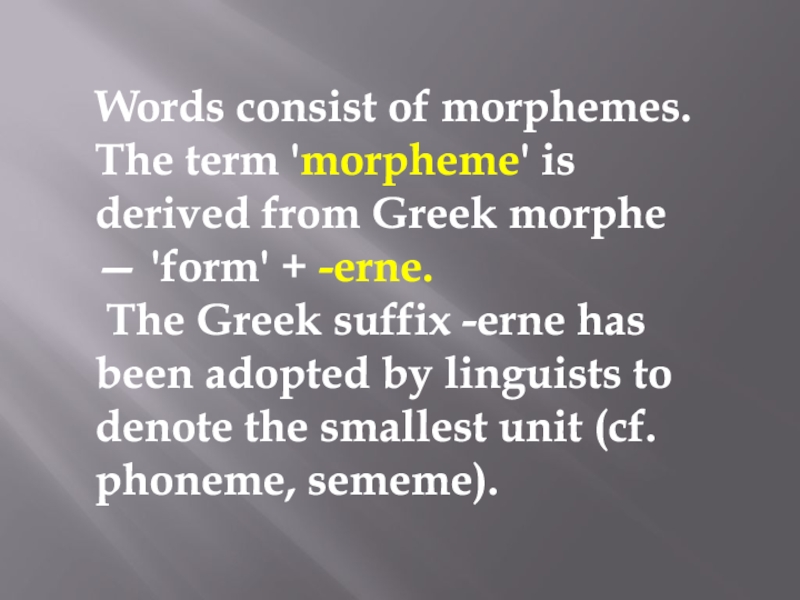
Слайд 3Morphemes occur in speech only as constituent parts of words
but not independently. Morphemes may have different phonetic shapes
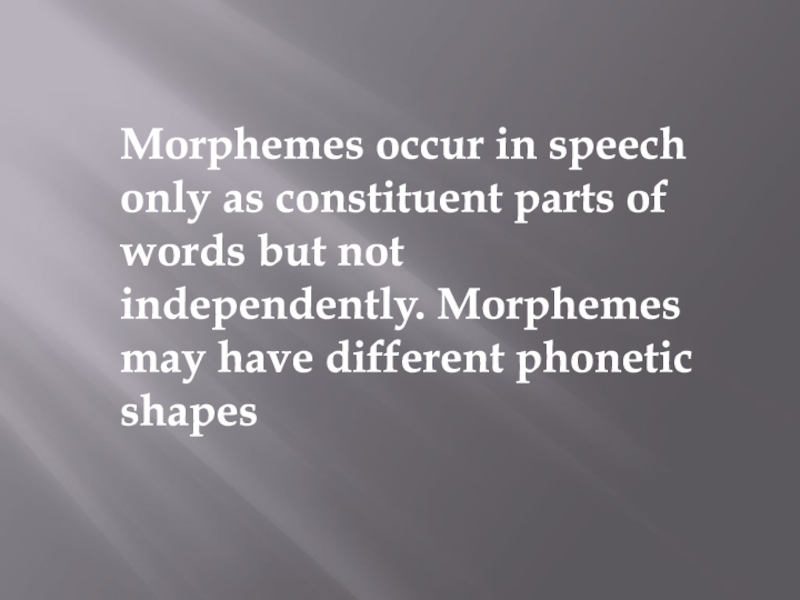
Слайд 4In the word-cluster please, pleasing, pleasure, pleasant the root morpheme
is represented by the phonetic shapes:
[pli:z-] in please, pleasing;
[ple3-] in pleasure;
[plez-] in pleasant.
![Morphemes
Classification of Morphemes In the word-cluster please, pleasing, pleasure, pleasant the root morpheme is In the word-cluster please, pleasing, pleasure, pleasant the root morpheme is represented by the phonetic shapes: [pli:z-]](https://theslide.ru/img/tmb/6/581145/5ef4242fd4343b5daad12ea743aee371-800x.jpg)
Слайд 5Root-morphemes are the lexical nucleus of words.
For example, in
the words remake, glassful, disorder the root-morphemes -make, glass- and
-order are understood as the lexical centres of the words
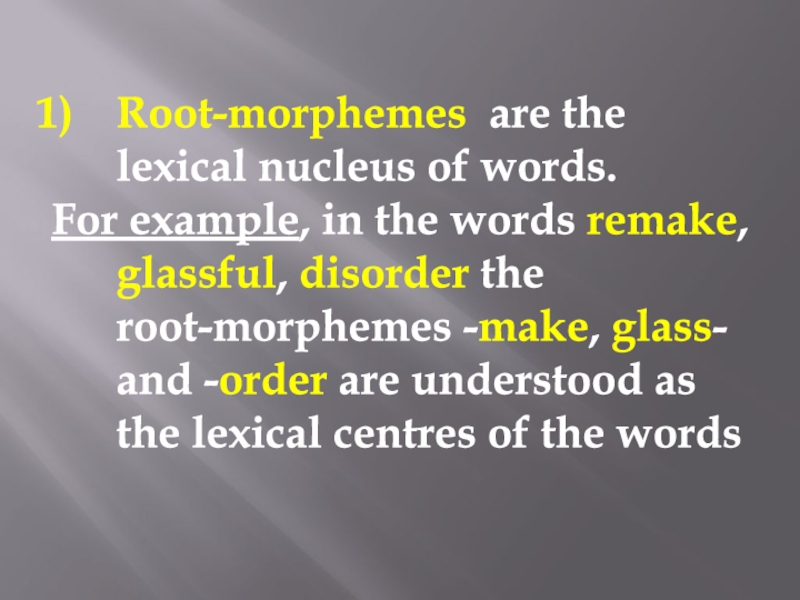
Слайд 6Non-root morphemes include inflectional morphemes and affixational morphemes . Inflections
carry only grammatical meaning and are thus relevant only for
the formation of word-forms, whereas affixes are relevant for building various types of stems’.
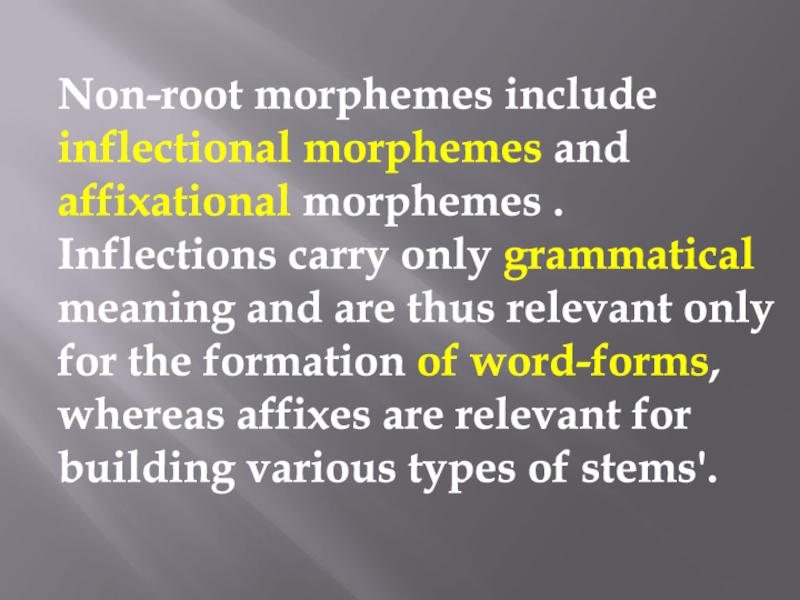
Слайд 7A prefix is a derivational morpheme preceding the root-morpheme and
modifying its meaning (pronounce — mis-pronounce, safe — un-safe).
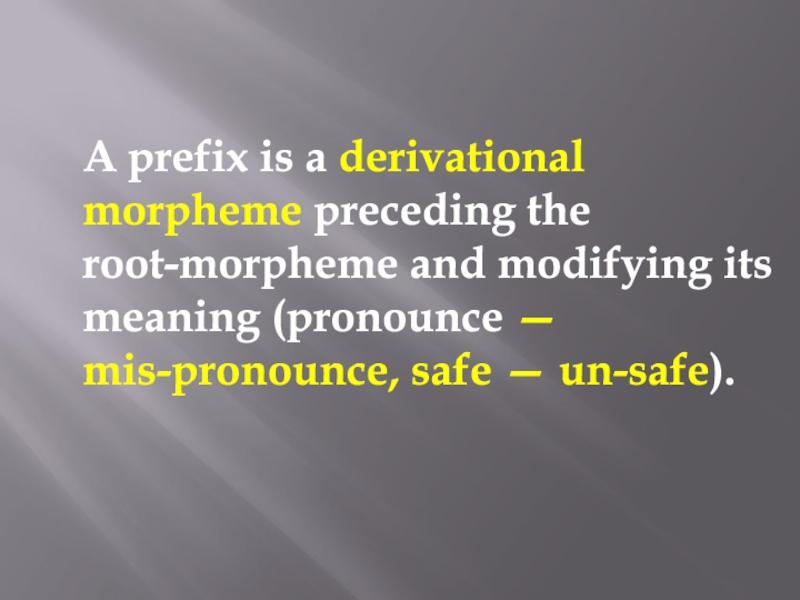
Слайд 8 A suffix is a derivational morpheme following the
root and forming a new derivative in a different part
of speech or a different word class (cf. -en, -y, -less heart-en, heart-y,heart-less).
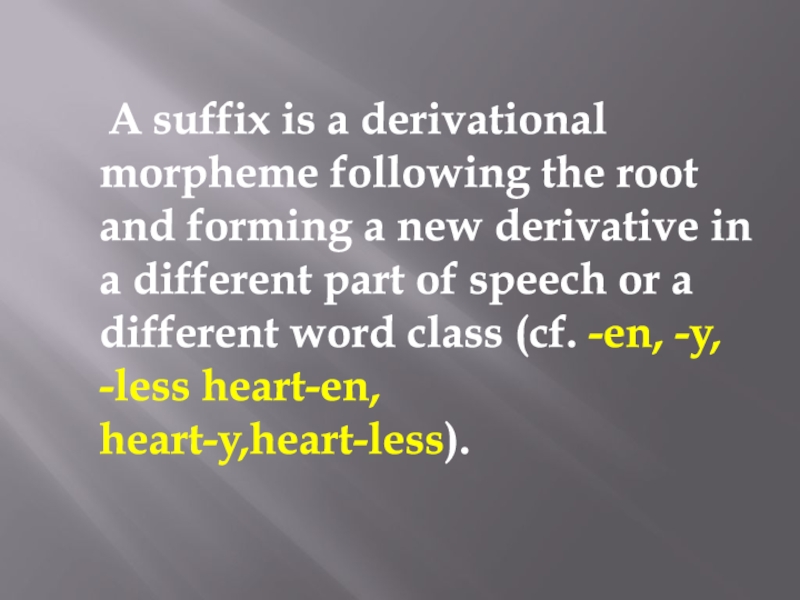
Слайд 91) Free morpheme is defined as one that coincides with
the stem or a word form. For example, the root-morpheme
friend- of the noun friendship is naturally qualified as a free morpheme because it coincides with one of the forms of the word friend.
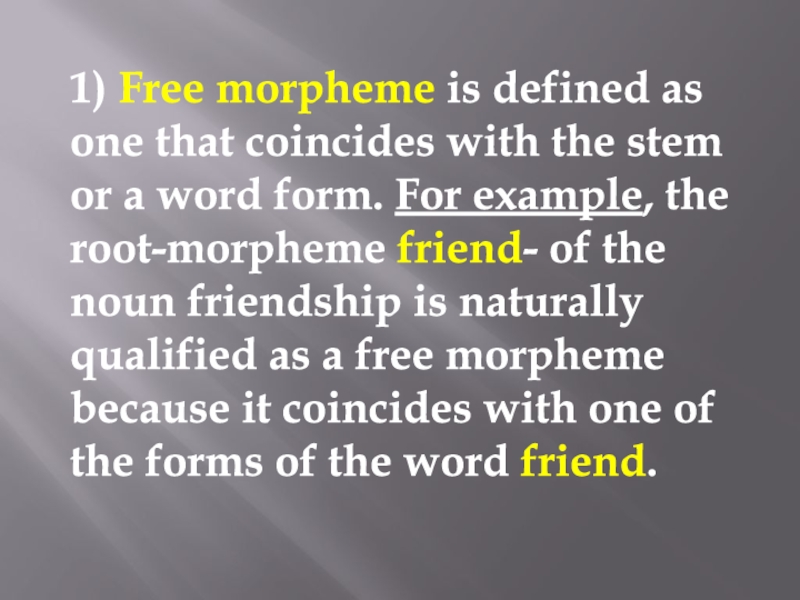
Слайд 102) Bound morpheme occurs only as a constituent part of
a word. Affixes are bound morphemes for they always make
part of a word. For example, the suffixes -ness, -ship, -ize in the words darkness, friendship, to activize, the prefixes im-, dis-, de- in the words impolite, to demobilize.
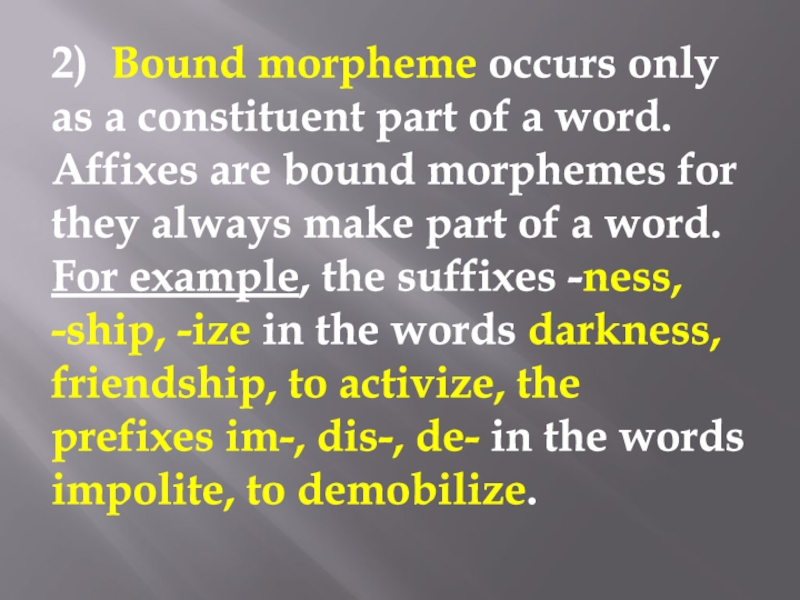
Слайд 113) Semi-bound (semi-free) morphemes are morphemes that can function in
a morphemic sequence both as an affix and as a
free morpheme. For example, the morphemes well and half on the one hand occur as free morphemes that coincide with the stem and the word-form in the utterances to sleep well, half an hour, on the other hand well and half occur as bound morphemes in the words well-known, half-done.
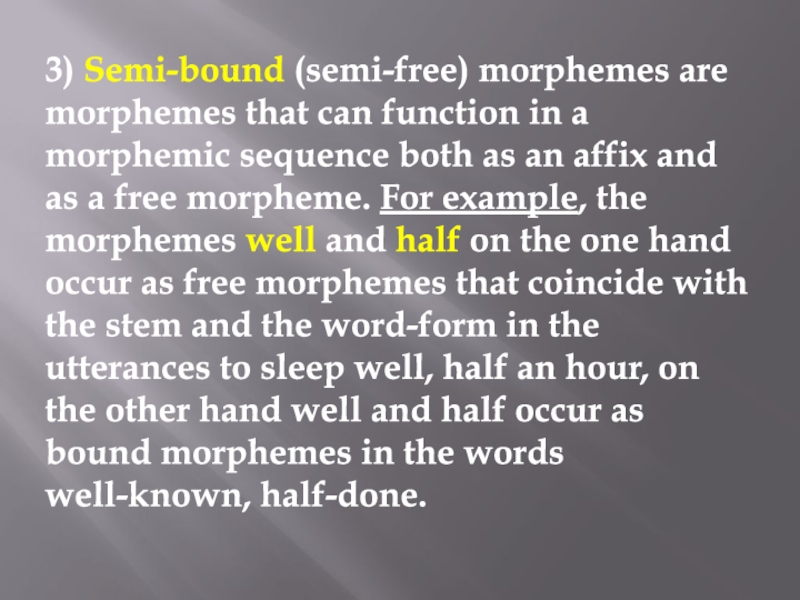
Morphology is the study of words and their parts. Morphemes, like prefixes, suffixes and base words, are defined as the smallest meaningful units of meaning. Morphemes are important for phonics in both reading and spelling, as well as in vocabulary and comprehension.
Why use morphology
Teaching morphemes unlocks the structures and meanings within words. It is very useful to have a strong awareness of prefixes, suffixes and base words. These are often spelt the same across different words, even when the sound changes, and often have a consistent purpose and/or meaning.
Types of morphemes
Free vs. bound
Morphemes can be either single words (free morphemes) or parts of words (bound morphemes).
A free morpheme can stand alone as its own word
- gentle
- father
- licence
- picture
- gem
A bound morpheme only occurs as part of a word
- -s as in cat+s
- -ed as in crumb+ed
- un- as in un+happy
- mis- as in mis-fortune
- -er as in teach+er
In the example above: un+system+atic+al+ly, there is a root word (system) and bound morphemes that attach to the root (un-, -atic, -al, -ly)
system = root un-, -atic, -al, -ly = bound morphemes
If two free morphemes are joined together they create a compound word. These words are a great way to introduce morphology (the study of word parts) into the classroom.
For more details, see:
Compound words
Inflectional vs. derivational
Morphemes can also be divided into inflectional or derivational morphemes.
Inflectional morphemes change what a word does in terms of grammar, but does not create a new word.
For example, the word <skip> has many forms: skip (base form), skipping (present progressive), skipped (past tense).
The inflectional morphemes -ing and -ed are added to the base word skip, to indicate the tense of the word.
If a word has an inflectional morpheme, it is still the same word, with a few suffixes added. So if you looked up <skip> in the dictionary, then only the base word <skip> would get its own entry into the dictionary. Skipping and skipped are listed under skip, as they are inflections of the base word. Skipping and skipped do not get their own dictionary entry.
Skip
verb, skipped, skipping.
- to move in a light, springy manner by bounding forward with alternate hops on each foot. to pass from one point, thing, subject, etc.,
- to another, disregarding or omitting what intervenes: He skipped through the book quickly.
- to go away hastily and secretly; flee without notice.
From
Dictionary.com — skip
Another example is <run>: run (base form), running (present progressive), ran (past tense). In this example the past tense marker changes the vowel of the word: run (rhymes with fun), to ran (rhymes with can). However, the inflectional morphemes -ing and past tense morpheme are added to the base word <run>, and are listed in the same dictionary entry.
Run
verb, ran, run, running.
- to go quickly by moving the legs more rapidly than at a walk and in such a manner that for an instant in each step all or both feet are off the ground.
- to move with haste; act quickly: Run upstairs and get the iodine.
- to depart quickly; take to flight; flee or escape: to run from danger.
From
Dictionary.com — run
Derivational morphemes are different to inflectional morphemes, as they do derive/create a new word, which gets its own entry in the dictionary. Derivational morphemes help us to create new words out of base words.
For example, we can create new words from <act> by adding derivational prefixes (e.g. re- en-) and suffixes (e.g. -or).
Thus out of <act> we can get re+act = react en+act = enact act+or = actor.
Whenever a derivational morpheme is added, a new word (and dictionary entry) is derived/created.
For the <act> example, the following dictionary entries can be found:
Act
noun
- anything done, being done, or to be done; deed; performance: a heroic act.
- the process of doing: caught in the act.
- a formal decision, law, or the like, by a legislature, ruler, court, or other authority; decree or edict; statute; judgement, resolve, or award: an act of Parliament.
From
Dictionary.com — act
React
verb
- to act in response to an agent or influence: How did the audience react to the speech?
- to act reciprocally upon each other, as two things.
- to act in a reverse direction or manner, especially so as to return to a prior condition.
From
Dictionary.com — react
Enact
verb
- to make into an act or statute: Parliament has enacted a new tax law.
- to represent on or as on the stage; act the part of: to enact Hamlet.
From
Dictionary.com — enact
Actor
noun
- a person who acts in stage plays, motion pictures, television broadcasts, etc.
- a person who does something; participant.
From
Dictionary.com — actor
Teachers should highlight and encourage students to analyse both Inflectional and Derivational morphemes when focussing on phonics, vocabulary, and comprehension.
For more information, see:
Prefixes, suffixes, and roots/bases
Many morphemes are very helpful for analysing unfamiliar words. Morphemes can be divided into prefixes, suffixes, and roots/bases.
- Prefixes are morphemes that attach to the front of a root/base word.
- Suffixes are morphemes that attach to the end of a root/base word, or to other suffixes (see example below)
- Roots/Base words are morphemes that form the base of a word, and usually carry its meaning.
- Generally, base words are free morphemes, that can stand by themselves (e.g. cycle as in bicycle/cyclist, and form as in transform/formation).
- Whereas root words are bound morphemes that cannot stand by themselves (e.g. -ject as in subject/reject, and -volve as in evolve/revolve).
Most morphemes can be divided into:
- Anglo-Saxon Morphemes (like re-, un-, and -ness);
- Latin Morphemes (like non-, ex-, -ion, and -ify); and
- Greek Morphemes (like micro, photo, graph).
It is useful to highlight how words can be broken down into morphemes (and which each of these mean) and how they can be built up again).
For example, the word <unreliability> may be unfamiliar to students when they first encounter it.
If <unreliability> is broken into its morphemes, students can deduce or infer the meaning.
So it is helpful for both reading and spelling to provide opportunities to analyse words, and become familiar with common morphemes, including their meaning and function.
Compound words
Compound words (or compounds) are created by joining free morphemes together. Remember that a free morpheme is a morpheme that can stand along as its own word (unlike bound morphemes — e.g. -ly, -ed, re-, pre-). Compounds are a fun and accessible way to introduce the idea that words can have multiple parts (morphemes). Teachers can highlight that these compound words are made up of two separate words joined together to make a new word. For example dog + house = doghouse
Examples
- lifetime
- basketball
- cannot
- fireworks
- inside
- upside
- footpath
- sunflower
- moonlight
- schoolhouse
- railroad
- skateboard
- meantime
- bypass
- sometimes
- airport
- butterflies
- grasshopper
- fireflies
- footprint
- something
- homemade
- backbone
- passport
- upstream
- spearmint
- earthquake
- backward
- football
- scapegoat
- eyeball
- afternoon
- sandstone
- meanwhile
- limestone
- keyboard
- seashore
- touchdown
- alongside
- subway
- toothpaste
- silversmith
- nearby
- raincheck
- blacksmith
- headquarters
- lukewarm
- underground
- horseback
- toothpick
- honeymoon
- bootstrap
- township
- dishwasher
- household
- weekend
- popcorn
- riverbank
- pickup
- bookcase
- babysitter
- saucepan
- bluefish
- hamburger
- honeydew
- thunderstorm
- spokesperson
- widespread
- hometown
- commonplace
- supermarket
Example activities of highlighting morphemes for phonics, vocabulary, and comprehension
There are numerous ways to highlight morphemes for the purpose of phonics, vocabulary and comprehension activities and lessons.
Highlighting the morphology of words is useful for explaining phonics patterns (graphemes) and spelling rules, as well as discovering the meanings of unfamiliar words, and demonstrating how words are linked together. Highlighting and analysing morphemes is also useful, therefore, for providing comprehension strategies.
Examples of how to embed morphological awareness into literacy activities can include:
- Sorting words by base/root words (word families), or by prefixes or suffixes
- Word Detective — Students break longer words down into their prefixes, suffixes, and base words
- e.g. Find the morphemes in multi-morphemic words like: dissatisfied unstoppable ridiculously hydrophobic metamorphosis oxygenate fortifications
- Word Builder — students are given base words and prefixes/suffixes and see how many words they can build, and what meaning they might have:
- Prefixes: un- de- pre- re- co- con-
Base Words: play help flex bend blue sad sat
Suffixes: -ful -ly -less -able/-ible -ing -ion -y -ish -ness -ment - Etymology investigation — students are given multi-morphemic words from texts they have been reading and are asked to research the origins (etymology) of the word. Teachers could use words like progressive, circumspect, revocation, and students could find out the morphemes within each word, their etymology, meanings, and use.

